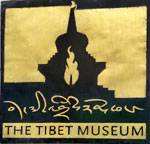
 June 27, 2018
June 27, 2018
Visiting the Tibet Museum
Location: Tibet Museum, McLeod Ganj (suburb), Dharamshala (city), Himachal Pradesh (state), India
Website: http://tibetmuseum.org
The Tibetan Cause
Tibet Museum isn't about Tibetan culture, tradition or religion but about Tibet's crusade against Chinese illegal occupation of Tibet and brutal repression of the Tibetans who struggle for freedom.
Ringside Seat
China's invasion of Tibet and human rights abuses inflicted on the Tibetans is a matter of public record - thanks largely to the efforts of His Holiness, the Dalai Lama in bringing worldwide attention to this tragedy. That's the big picture we see. But visiting the Tibet Museum and learning details of what happened and what continues to happen puts you on ringside seat as events unfold.
History
The museum features in pictures and written narrative the historical accounts that shaped Tibet from the earliest records up to the present day. The focus begins on the 1950s when Chinese aggression began to escalate leading to the Dalai Lama's daring escape through the harsh Himalayan mountains into the safety of India in 1959. What followed was the inhumane brutalization of the Chinese against the peaceful Tibetan monks in occupied-Tibet not unlike ethnic cleansing that has taken place in Rwanda. More than 150 Tibetans have put themselves on fire in protest of the Chinese invasion. The Chinese have destroyed over 6000 monasteries, burned sacred manuscripts and killed, tortured and imprisoned hundreds of thousands of Tibetans in the process. Han and Hue Chinese are resettled in large numbers into Tibet, reducing the Tibetans as minority in their own country. The Chinese have also wreaked havoc into Tibet's ecology through nuclear testing, mining and indiscriminate deforestation.

Autonomous Tibet vs. Independent Tibet
In the late 80s, there has been a radical shift in policy which puts the Dalai Lama between a rock and a hard place. In a pragmatic but surprising move, after decades of brutal oppression by the Chinese, the Dalai Lama proposed the Middle Path - that Tibet be autonomous and not independent. Tibetans can regain some control of their lives through a degree of self-governance instead of being crushed. Their religion and culture will be preserved instead of being erased. On the other hand, it also means Tibet will forever be a part of China and permanently lose its sovereignty. But despite the Tibetan back-bending, the Chinese have arrogantly rejected the Middle Path in 2008. The Dalai Lama continues to keep the Middle Path policy.
This creates a sharp division within the Tibetans. The hardliners, after the torture and imprisonment they've endured, would rather die fighting than be marginalized second class Chinese citizens in their own country. Others object but remain drawn to their allegiance to the Dalai Lama. This rift is a great divide to what was once a solid and unified Tibetan resolve.
Ending Thoughts
I speculate that the clever Chinese are just awaiting for the Dalai Lama to pass on - that is why they are not sitting on the negotiating table. His Holiness is now 83 years old and not in the best of health. It won't take long. When he is gone, Tibet loses whatever global attention it still enjoys. This makes it easier for the Chinese to continue its repression without the global attention. It will be easier for them to completely subdue all Tibetans within occupied-Tibet. They can brutally crush a protest, put the Tibetans into indentured slavery, erase Tibetan Buddhism and wipe-out any remnant of Tibetan culture! If the international community has done nothing to free Tibet while the Dalai Lama is alive, how much less will they be doing when he is already gone?
China is now the uncontested Big Bully of Asia. It invades, occupies and brutalizes everything in its way to gain global dominance. Not only has it crushed with impunity the peaceful Tibetans but also illegally claimed, occupied and militarized nearly all the islands in the South China Sea which have originally belonged to these Asean countries. China continues its blatant aggression while the free world at large looks on indifferently - countries in high places might release a protest statement or two but it ends there. No meaningful action has been done by the international community to stem China's unrestrained aggression.
Tibet Museum keeps the struggle alive for Tibet's freedom. Through this institution, visitors in Dharamshala are given a ringside seat to Tibet's plight, giving the struggle flesh and blood to what otherwise might be relegated as staid 2-dimensional news.
--- TheLoneRider
YOGA by Gigit ![]() |
Learn English
|
Learn English ![]() |
Travel like a Nomad
|
Travel like a Nomad ![]() |
Donation Bank
|
Donation Bank ![]()
Reader Comments:
 Ben
Ben (July 2018) Thanks for sharing and enlightening us on this subject. I PRAY this will not happen to our country because, just like Tibet, we are also as helpless and as small when compared to China..... Be careful.
(July 2018) True. Thank you Tito Ben.
 Rachel
Rachel (July 1, 2018) Filipinos can learn from what China did to Tibet.
(July 1, 2018) True. I would not trust the Chinese. The Philippines is on slippery slope with all of Duterte's sweetheart-deals with them.
Next stop:

![]()

![]()
16 Days in McLeod Ganj, Dharamshala: Goodbye India
(June 23-July 8, 2018) With an offer to teach yoga and a barter-deal for a roof over my head, I left the bliss of Upper Bhagsu to stay 16 days at Pema Thang Guest House in McLeod Ganj. It was a different scene altogether and a different challenge.....more »»
Dharamshala Map

Dharamshala (city), India
 Pema Thang Guest House & Restaurant - central McLeod Ganj location, quiet area, Kangra Valley view, near Tsuklakhang (main temple) and market
Pema Thang Guest House & Restaurant - central McLeod Ganj location, quiet area, Kangra Valley view, near Tsuklakhang (main temple) and market
Dharamshala, HP 176057 INDIA
Travel Tips
- the Dalai Lama's scheduled public teachings in Dharamshala are as follows: September 4-7, 2018 | October 3 - 6, 2018 | February 19, 2019. To register, visit this page: https://www.dalailama.com/office/contact
- in June, the average temperature high is 31° and average low is 21°. It rains usually in the afternoon/evening beginning mid-June
- July and August see the most rainfall, up to 22 inches
- Dharamshala International Film Festival (DIFF) happens 30 October to 2 November in McLeod Ganj
- at the Tibetan Museum in McLeod Ganj, there is a daily 11am and 3pm movie screening of Tibet-related issues at INR 10
- trekking is one of the highlights in Dharamshala - to Dharamkot, Bhagsu, cutting through Dhauladhar to the upper Ravi Valley and Chamba district, or the 8km trek to Triund
- Wednesday is vegetarian day - other days, meat dishes are served by cafes and restaurants
- Bhagsu and Dharamkot are a quiet alternative to McLeod Ganj. They are also cheaper in accommodation when the Dalai Lama is in town and McLeod Ganj hostels are fully booked (with inflated prices)
- If you wish to stay in McLeod Ganj but want quiet, stay along Jogiwara Road where balconies will offer scenic views
- short power outages frequently happen during the day
- for quiet stays and scenic views, stay in Upper Dharamkot or Upper Bhagsu. The "upper" you go, the cheaper the accommodation prices go.
- in Upper Dharamkot is a cluster of cafes and lodging (Salvation Cafe area)where the community is chill
How to get to Dharamshala from Rishikesh by bus
 Bus - Rishikesh to Dharamshala is 449 kms. The usual route is to go to Haridwar and take the State transport buses to Lower Dharamshala, but it's less hassle to get a bus from Rishikesh that go all the way up to McLeod Ganj - a little more money (INR 1150) but worth it specially if you a carry bulky pack. You will leave Rishikesh 4pm and arrive in Dharamshala the following day (you save one night lodging) at 7am.
Bus - Rishikesh to Dharamshala is 449 kms. The usual route is to go to Haridwar and take the State transport buses to Lower Dharamshala, but it's less hassle to get a bus from Rishikesh that go all the way up to McLeod Ganj - a little more money (INR 1150) but worth it specially if you a carry bulky pack. You will leave Rishikesh 4pm and arrive in Dharamshala the following day (you save one night lodging) at 7am.
How to get to New Delhi Airport from McLeod Ganj, Dharamshala by bus
 Bus From McLeod Ganj bus station, take a semi-sleeper a/c overnight bus, INR 1000, 11.5 hours (7pm to 6:30am) straight to Kashmiri Gate Train Station in New Delhi.
Bus From McLeod Ganj bus station, take a semi-sleeper a/c overnight bus, INR 1000, 11.5 hours (7pm to 6:30am) straight to Kashmiri Gate Train Station in New Delhi.- walk to Kashmiri Gate (no need to ride a tuktuk)
- take the Yellow Line towards Huda City but get off at New Delhi Station (INR 16)
- From New Delhi Station, take the Airport Metro Train (INR 60) and get off at the airport
Travel Tips for India
- e-VISA - visa on arrival is no longer done. Tourists should apply online for an e-VISA. Tourist e-VISA for 60 days = US$51.25 (including surcharges, non-refundable). NOTE: e-VISA is only honored in 25 designated airports and 5 designated seaports (Cochin, Goa, Mangalore,Mumbai,Chennai). You CANNOT do a land crossing using an e-VISA.
- US$1 = Indian Rupee (INR) 67.18
- nearly every food served is spicy...there is no escaping it
- other travel destinations in India
- always good to have an Indian SIM. It's handy to get wifi in some cafes
General Travel Tips
- arrive early - in case there is a snag (visa snag, documentation snag, transport ticket snag, etc.), you will have ample time to troubleshoot the problem if you arrive early (to the airport, to the bus terminal, etc.)
- put detailed itinerary on the Calendar apps of your smart-phone according to timelines - this is where you do all your thinking and planning. Once written down, you don't have to think anymore while you are on the journey...you just follow the steps. This frees your mind for something else that might happen while you are already en route
- avoiding scams - as a general rule, I ignore the touts or anyone I don't know who call out to me. The calling comes in many forms - "Hi! Where are you from?", "Excuse me! Excuse me!", "Where are you going?". I don't look them in the eye and I remain non-verbal with them. If you reply to them, you just gave them an 'in' to hound you. In order not to look rude, I smile and wave the 'not interested' hand to them, without looking at them.
- power bank - hand-carry your power bank. Do not check it in. You can be called in when you are already inside the plane to go all the way to the loading dock so you can personally remove the power bank...and chances are, you'll have to surrender it to them. And you might delay the plane departure!
India Blogs
- 16 Days in McLeod Ganj, Dharamshala: Goodbye India June 23-July 8, 2018
- Peoplescape of Dharamshala, India June 14 - July 8, 2018
- Visiting the Tibet Museum June 27, 2018
- In Search of a Tibetan Yantra Yoga Teacher June 25, 2018
- Conducting Yoga Classes at Pema Thang Guest House, Dharamshala, India June 24 - July 8, 2018
- Life in Upper Bhagsu, Dharamshala June 16-23, 2018
- Trekking to Naddi from Upper Bhagsu, Dharamshala June 19, 2018
- Matters of the Heart Jun 17, 2018
- A First Timer in Dharamshala Jun 14, 2018
- 29 Hours in New Delhi Airport July 9-10, 2018
- Meditation with Shirly Pnina at Lodi Garden, New Delhi May 15, 2018
- A First-Timer in New Delhi, India May 12-17, 2018
- A 26-Day Mini-Life in Rishikesh May 18 - June 13, 2018
- Peoplescape of Rishikesh May 18 - June 13, 2018
- Rafting the Ganga River with Greg Goldstein June 1, 2018
- White Water Rafting on Ganga River, Rishikesh May 25, 2018
- Satsang (spiritual discourse) by Sadhvi Bhagawati Saraswati May 21, 2018
- Ganga Aarti (devotional fire ritual) at Parmarth Niketan Ashram May 21, 2018
- Bouncing Back into Yoga in Rishikesh May 21, 2018
- Exploring Rishikesh, India May 18, 2018
- India e-VISA snag May 9, 2018
SONAULI
Currency Converter
»» back to Traveling
»» back to Homepage
ARCHIVE 2025:
JAN |
FEB |
MAR
1970 |
1973 |
1975 |
1976 |
1977 |
1979 |
1981 |
1996 |
2000 |
2001 |
2002 |
2003 |
2004 |
2005 |
2006 |
2007 |
2008 |
2009 |
2010 |
2011 |
2012 |
2013 |
2014 |
2015 |
2016 |
2017 |
2018 |
2019 |
2020 |
2021 |
2022 |
2023 |
2024 |
2025 |
ALL BLOGS
